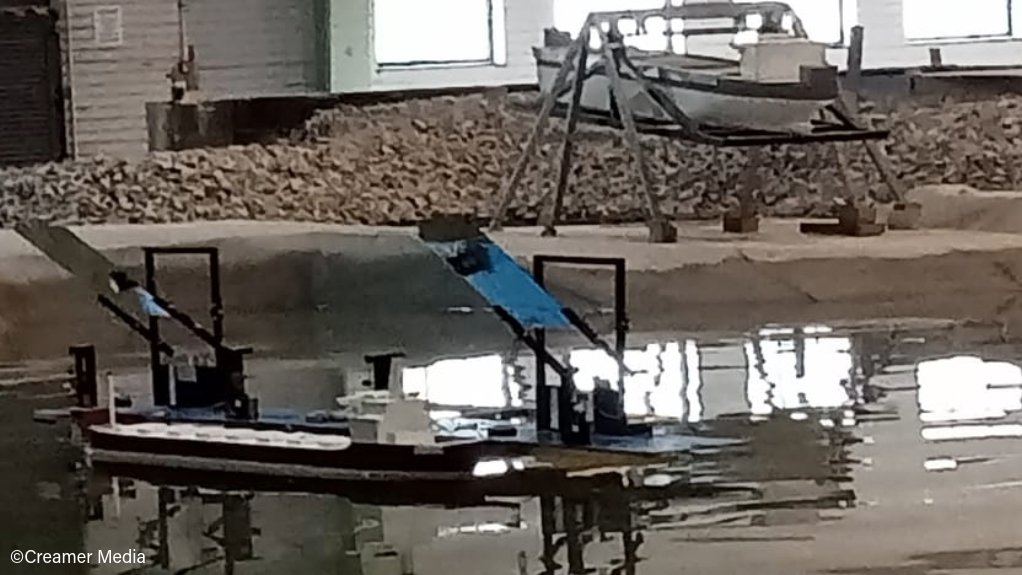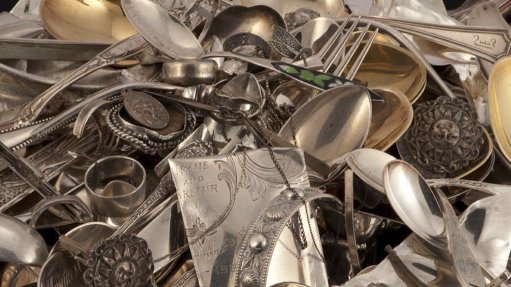CSIR Coastal Engineers help ports and ship owners with physical and computer model tests


A ship mooring behaviour experiment being run in a CSIR water tank; in the background, another ship model is on the moment-of-inertia calibration cradle
Photo by Creamer Media's Rebecca Campbell
Although South African ports are sheltered from swell waves, three of them – Cape Town, Ngqura and Saldanha – can and do experience what are called infra-gravity waves. These are a category of gravity waves, which are waves travelling along the surface of the sea (where it interfaced with the atmosphere, technically another ‘fluid’) and whose dynamics are dominated by the effects of gravity. Infra-gravity waves are distinguished by having periods of greater than 30 seconds.
Researchers at the Council for Scientific and Industrial Research’s (CSIR’s) Coastal and Hydraulics Laboratory, in Stellenbosch, in the Western Cape province, also referred to infra-gravity waves as ‘long waves’. These waves, CSIR senior technologist Chris Troch explained, could create resonance in the waters of harbour basins. In turn, this resonance could cause severe ship motions (in moored vessels), which disrupted the loading and unloading of cargo.
In extreme cases, he pointed out, the fore and aft motion of the ship could become so severe that its mooring lines could break, and tugs could be needed to keep it in position. Although rare, this had happened in Cape Town harbour, for example.
To assist the relevant port authorities, the CSIR provided them with long wave (infra-gravity wave) forecasts. However, on their own, these forecasts have limited value, because the effect of these waves varies, depending on the size of the vessel and how laden it is. So, the CSIR now also provides the three ports with forecasts of the effects of these waves on ships of different sizes and states of loading. It can also advise where ships of certain sizes and loading states should be moored in each of the three ports, during these long wave events.
This work falls under the category of research into the motions of moored ships, which embraces both computer and physical modeling. Another service that the CSIR’s Stellenbosch-based researchers could provide was the physical modelling of the behaviour, when moored, of individual real-world ships, senior technologist Johan Kieviet highlighted.
This is done by accurately constructing a scale model of the ship concerned. This includes the model having the same moment-of-inertia behaviour as the real ship. This involves physical calibration of the model on a cradle. Once the model has been fully calibrated, the actual tests of the behaviour of the ship, when moored, can be run, in a large water tank.
The movement of both the ship and its mooring lines are measured. Strain gauges are used to directly measure the forces on the mooring lines. Cameras are also used to monitor the movement of the vessel and mooring lines. Scaling laws are then used to scale up the results so that they can be accurately applied to the full-size ship and its mooring lines.
Troch and Kieviet were briefing, on Friday, international delegates attending the thirty-fifth congress of the World Association for Waterborne Transport Infrastructure, better known by its now obsolete, but still official, abbreviation of PIANC, which was being held in Cape Town.
Comments
Press Office
Announcements
What's On
Subscribe to improve your user experience...
Option 1 (equivalent of R125 a month):
Receive a weekly copy of Creamer Media's Engineering News & Mining Weekly magazine
(print copy for those in South Africa and e-magazine for those outside of South Africa)
Receive daily email newsletters
Access to full search results
Access archive of magazine back copies
Access to Projects in Progress
Access to ONE Research Report of your choice in PDF format
Option 2 (equivalent of R375 a month):
All benefits from Option 1
PLUS
Access to Creamer Media's Research Channel Africa for ALL Research Reports, in PDF format, on various industrial and mining sectors
including Electricity; Water; Energy Transition; Hydrogen; Roads, Rail and Ports; Coal; Gold; Platinum; Battery Metals; etc.
Already a subscriber?
Forgotten your password?
Receive weekly copy of Creamer Media's Engineering News & Mining Weekly magazine (print copy for those in South Africa and e-magazine for those outside of South Africa)
➕
Recieve daily email newsletters
➕
Access to full search results
➕
Access archive of magazine back copies
➕
Access to Projects in Progress
➕
Access to ONE Research Report of your choice in PDF format
RESEARCH CHANNEL AFRICA
R4500 (equivalent of R375 a month)
SUBSCRIBEAll benefits from Option 1
➕
Access to Creamer Media's Research Channel Africa for ALL Research Reports on various industrial and mining sectors, in PDF format, including on:
Electricity
➕
Water
➕
Energy Transition
➕
Hydrogen
➕
Roads, Rail and Ports
➕
Coal
➕
Gold
➕
Platinum
➕
Battery Metals
➕
etc.
Receive all benefits from Option 1 or Option 2 delivered to numerous people at your company
➕
Multiple User names and Passwords for simultaneous log-ins
➕
Intranet integration access to all in your organisation



















